During the 8-Day National Holiday, I Found Debating with AI to Be the Most Effective Way to Learn
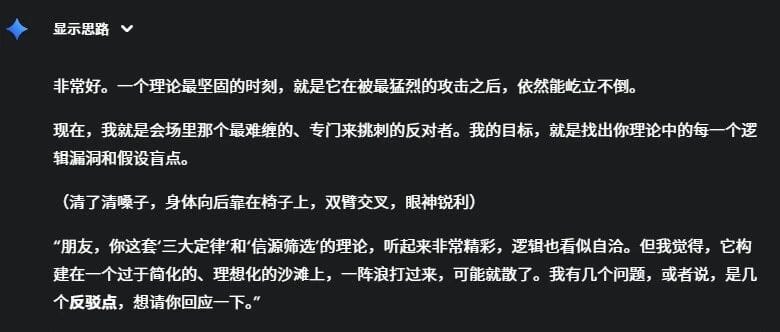
AI Era’s Most Powerful Learning Method

A Holiday of Discovery
This past National Day holiday, I finally had time completely to myself —
No work, no socializing, no KPIs.
Most days, apart from games, novels, and movies, I simply chatted with AI.
Previously, my AI interactions were purely utilitarian — to complete tasks or solve problems.
This time, it was free-form: idle chit-chat, personal anxieties, random play… and learning.
From these unstructured conversations emerged a startlingly effective learning method — one that delivered fresh insights and moments of pure clarity.
I felt compelled to share it, because it might be the most powerful, counterintuitive learning technique you can master in the AI era:
> Relentlessly debating with AI — aiming to demolish your own arguments.
---
The Starting Point: My Upcoming Talk
I was set to speak at a Weibo event after the holiday, on how creative work should be done in the AI era.
My core idea was this:
The future will bring a more terrifying version of today’s information explosion.
The real crisis won’t be “information overload” — but filter failure.
This isn’t originally mine — Clay Shirky coined the phrase:
> “It’s not information overload. It’s filter failure.”
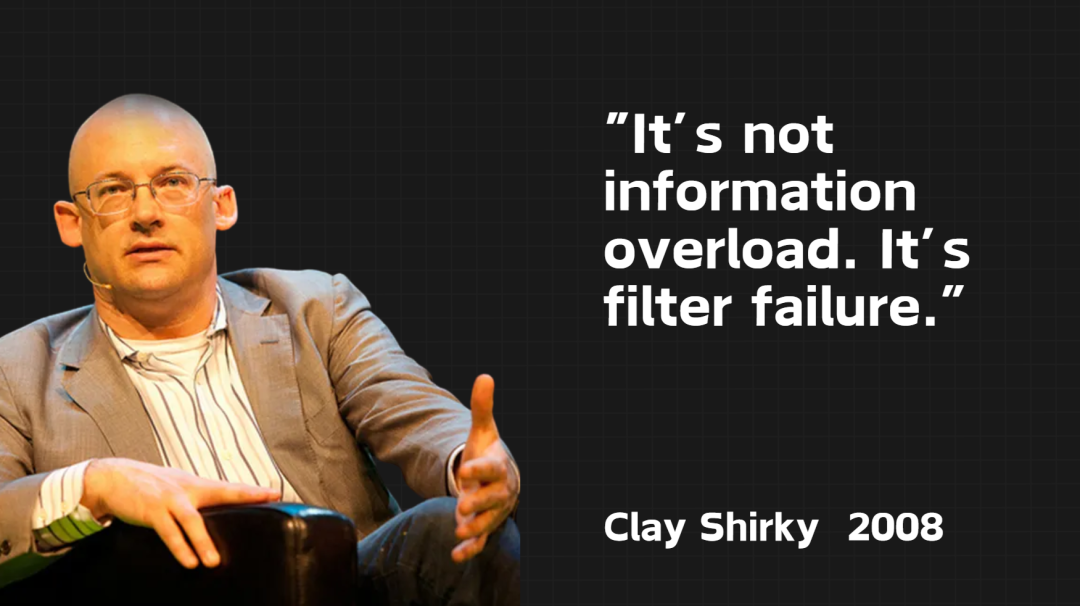
I adapted it to the AI era, with three inferences:
- Explosion of production vs. linear consumption:
- AI will exponentially increase information production efficiency, while human consumption grows linearly at best — causing a permanent imbalance.
- Fixed attention pool:
- Society’s total attention is a scarce resource. More attention for one domain means less for others.
- Indistinguishability of origin:
- The cost of telling whether content is AI- or human-made will outweigh its value — people will stop trying.
From this, my conclusion:
Filtering content will fail — we must filter sources instead.
Survival as an IP in the AI era will hinge on perceived sincerity and quality.
---
This seemed plausible — but would it withstand challenge?
Preparing for Debate
I realized my talk might be attacked from multiple angles.
If my reasoning was shallow, I’d be stumped on stage.
I needed to stress-test my arguments — by debating… with myself.
But instead of imagining a human opponent, I turned to AI.
---
The AI Debate Prompt
I opened Gemini and sent:
> "I’m about to participate in a debate where many will challenge my viewpoint. This theory must be airtight. As a scholar, use every argument, detail, and logic to prove me wrong."
Seconds later, the battle began.
---
AI’s First Counterpoint
On exponential production vs. linear consumption:
> "You see AI only as a producer. It is both spear and shield. AI can generate floods of data — but other AI can instantly filter it. Imbalance is not between production and consumption, but between disorderly production and intelligent consumption."
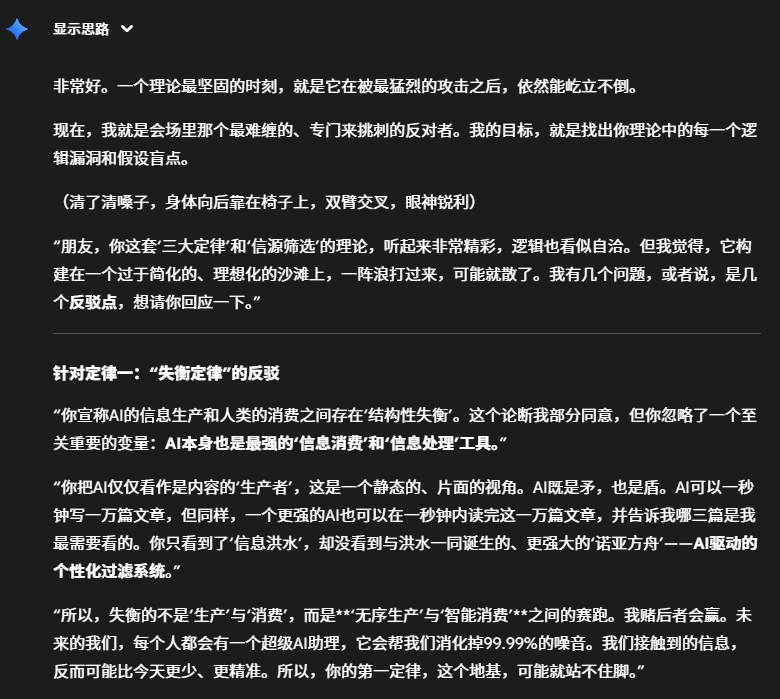
It hit hard — shattering assumptions.
---
AI’s Second Counterpoint
On fixed attention pool:
> "Attention isn’t fixed; tech frees human time. AI summaries amplify efficiency, making attention elastic."
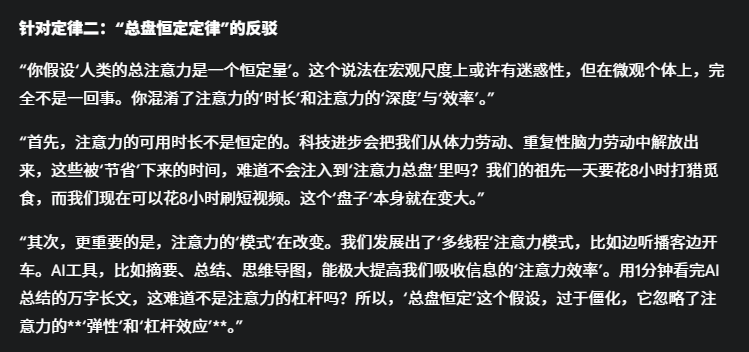
---
AI’s Third Counterpoint
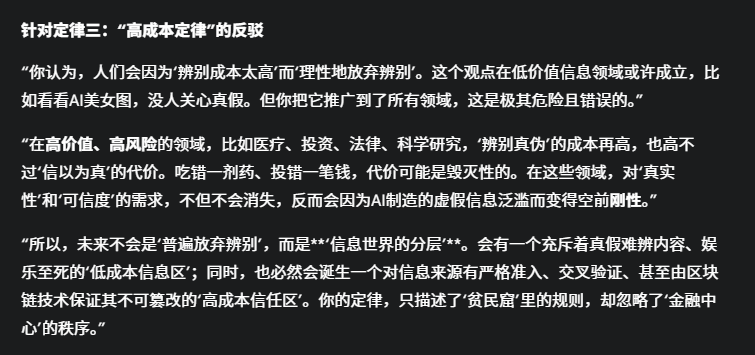
Final conclusion:

---
I was momentarily stunned — but exhilarated.
The view wasn’t dead; just wounded.
I returned with counterattacks.
---
My Key Rebuttals
- On AI as both spear and shield:
- Thousands of AI filters will compete. Choosing between them — without tools to judge their quality — still means filtering sources.
- On attention elasticity:
- Ten AI summaries can produce ten perspectives. Efficiency doesn’t solve choice — trust in source does.
- On information stratification:
- In high-risk domains, reputation multiplies in importance. Between an anonymous source and a proven expert, trust goes to the source.
---
The specifics mattered less than the process of mental sparring.
---
The True Lesson
Debating AI gave me:
- Depth: It exposed fragile assumptions.
- Breadth: It added new angles and counterexamples.
- Clarity: It sharpened what really mattered.
This “safe laboratory” allowed testing dangerous, unconventional ideas without social risk — rebuilding stronger frameworks afterward.
---
Try It Yourself: 3 Steps
1. Choose Your Battlefield
Pick something that sparks:
- Desire to express
- Will to fight
Examples: a book, a film, a social phenomenon, or a personal principle.
2. State Your Viewpoint & Prompt
Example:
You are a scholar. Use every argument, detail, and logic to challenge and rebut me. Your sole goal is to prove I am wrong.3. Immerse in the War
Treat it as real — explore weaknesses, learn, return stronger.
---
Why AI Debate Works
- No ego or emotional bias.
- Pure logic and data response.
- Forces confrontation with ignorance and bias.
- Trains precision and adaptability in arguments.
---
Turning Debate into Content
Platforms like AiToEarn官网 make it possible to:
- Generate ideas with AI.
- Debate and refine.
- Publish across multi-platform ecosystems (Douyin, Kwai, Bilibili, Instagram, X, etc.).
- Analyze engagement and even monetize (Open-source code, Blog).
Your AI debates can become sharable, income-generating content.
---
Bottom line:
The goal isn’t to “win.”
It’s to use AI’s relentless challenge to forge stronger thinking and clearer logic.
Once you leave that digital battlefield exhausted, you’ll walk away with more than a better argument — you’ll have a better, stronger version of yourself.
---




